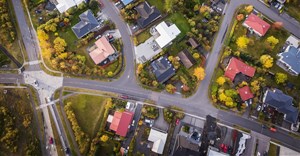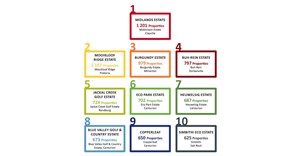#AfricaMonth
Subscribe & Follow
Elections 2024
Trending


 Woolworths sees over 20% drop in annual earningsAby Jose Koilparambil
Woolworths sees over 20% drop in annual earningsAby Jose Koilparambil


Jobs
- Customer Service (UK) Work from Home Nationwide
- Property Portfolio Manager Johannesburg North
- Property Portfolio Assistant George
Luxe estate living - the new thing in SA
275,000 properties are currently situated on estates dotted around South Africa. Of these, 85% are considered security estates, while another 12% are part of larger, more luxurious golfing estates.
Preceding the subprime mortgage crises that began in 2008, estate development was growing at an annual rate of close to 30%, with the major driver being a demand for secure living. Since 2008, estate inflation has stabilised and returned to pre-housing boom levels of about 7,5% every year and it seems to be growing. Analysts believe this will gradually get better, once economic growth picks up and household debt decreases.
With security becoming an increasing concern, estate living seems to be back on the up, and more interestingly, luxury country estate living.
Younger affluent buyers
"The market has changed with younger affluent buyers, between 30 and 45 years old, buying into a super-luxurious estate like ours," says Gawie Marx, General Manager for Pearl Valley Golf & Country Estate, a Jack Nicklaus signature golf course and luxury residential housing estate situated in the Berg River Valley, between Paarl and Franschhoek in the Western Cape.
"Little over a year ago, the average price for a freehold versus sectional title stand was at its highest, ever, possibly an indicator to the younger buyer that investing in estate living, and more specifically country estate living, offered attractive investment or retirement planning potential."
Marx and several other professionals in the property development space are noticing the opening up of country estate living, particularly those falling within the super luxury category. Several exist in the country, including Arabella Country Estate outside Hermanus, Blair Atholl Estate in Lanseria outside Johannesburg, Oubaai Golf Estate outside George and Cotswold Downs in Hillcrest, Kwazulu-Natal.

"A search for real value is key, with proximity to business centres and major freeways, and those with a luxury country feel dominating the upper-end rankings. This is largely driven by an increased need for security and less travel on congested roads, without compromising the benefits of city living," says Lightstone Analytics Director Paul-Roux de Kock.
In 2014, top Boland architectural design practice, Louis Phillips Architects & Associates, which has built more than 21 homes in estates like Pearl Valley, Diemersfontein and Val de Vie, estimates that 50% of their work is dedicated to country estate living.
"There has been a steady increase in people investing in country estate living, especially over the last three years," says practice owner Louis Phillips. "Buyers tend to engage us during the spring-summer period, as most people understand that starting the building process in mid-winter will result in delays when it comes to project rollout."
Unique design, practical, 'green'
Rebuffing Marx' assertion that younger buyers are moving more and more into the country estate living space, Phillips believes that buyers are wanting homes that offer a truly unique design look, that are practical, energy efficient and make full use of the environment; to say nothing of the spectacular views that these stands are often surrounded by.
Salone Internazionale del Mobile in Milan, the world's premier home furnisher says that design this year is drawing its inspiration from the surrounding natural and environmental feel of materials. That designing pieces starts with the materials themselves - it is no longer the case that materials are chosen with just the design in mind - with elements such as brushed glass, porous cork and cement or dense ceramic coming into play. 'Design' is clearly evident in the detailed workmanship applied to these materials. Colour is often used to enhance the detail, with natural hues such as copper, muted in reddish or slightly purple shades, or with petrol green, mould, mushroom and mud featuring quite prominently.
"Country estates normally carry strict architectural guidelines, although they allow enough flexibility to design something really unique, as in the case of Pearl Valley," comments Phillips. He says that living areas, which are flexible (utilised separately or combined) and carry a strong inside-outside connection, are what is on trend in country estate living. Design has to carry a strong focus on the climatic conditions, prevailing winds and views and a general respect for the surrounding environment.
A steady increase in building costs and electricity has seen the size of country estate homes becoming more compact. People are finding themselves in a position where there is a need to comply with new energy efficiency regulations in buildings and spending more to get their homes efficient. Choices of floor finishes are crucial to giving a warmer feel under the foot, with a demand for engineered wooden flooring becoming greater.
With the natural environment really shaping design, timeless contemporary finishes in light tones, natural granite, engineered timber flooring with high gloss finishes or accent colours are featuring more prominently.
One of Salone Internazionale del Mobile's opening trends this year, which supports this newfound 'respect' for the environment and a deliberate move away from the excesses predating the 2008 financial crisis, is 'positive pauperism'. Designers are focusing on leaner, starker product, which is based on available resources and carries figurative references. There is a general 'paring down' in design, with furniture becoming a lot more functional and natural elements like metal being subtly revealed.
In closing, Phillips says that fixed item trends would normally take longer to shift than the softer, more usable finishes.
"Materials are expensive and clients are going for neutral durable finishes that are timeless, especially when it comes to floor finishes, sanitaryware and joinery. Soft furnishings, furniture, décor items, paint and items like wallpaper are things that will change more quickly in time."











